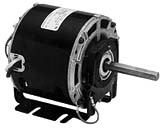One component in particular strikes at the heart of a system's efficiency: the motor.
The motor type and, perhaps more importantly, its maintenance have a great effect on overall system efficiency.
Mark Kendall, director of technical services for the Gas Appliance Manufacturers Association (GAMA), Arlington, Va., recently addressed an audience of HVAC engineers at the 2004 ASHRAE Winter Meeting in Anaheim, Calif. His topic was "Energy-Saving Opportunities in Residential Air Handler Efficiency."
"The typical gas furnace uses 730 kWh in the heating season," he stated. "It accounts for 10 percent of a home's typical energy use." The blower fan also is used with the A/C system, he pointed out. "There is an interest in promoting high-efficiency motors."
Kendall said that in the United States there are:
The two dominant motor technologies, he said, are permanent-split capacitor (PSC) and brushless direct current (BDC). PSC motors are AC motors; the speed is controlled via voltage to different motor taps, with no integrated controls. As the name implies, BDC motors are DC motors; the speed is controlled via a voltage modulator, and they have integrated controls.
"There are significant energy savings with a two-speed furnace," Kendall said. However, "The homeowner uses more fuel with BDC technology in the heating season - the furnace is on for longer periods."

Economics
A more-efficient fan motor will reduce electricity only if it raises the SEER of the air conditioner, he continued. "It may not be worth it on a 13-SEER unit." If the homeowner replaces the furnace but not the air conditioner, Kendall said, "you will save energy in the cooling system."He pointed out three misconceptions about fan efficiency:
1. SEER ignores the cooling load added by the circulating fan motor. Motor heat decreases the SEER by reducing cooling capacity and increasing power consumption.
2. Default fan power is optional or mandatory. You can choose to test it with the blower on a matched system.
3. There is understated static pressure. In fact, "BDC motors can draw more than typical PSC motors at high static pressures," Kendall said.
In order to reduce cooling season energy consumption, the owner should focus on the SEER of the system rather than components such as motors, Kendall said. "SEER provides proper incentives to improve fan efficiency."
Year-round operation of BDCs offer substantial savings, he said. However, no one would recommend the constant use of the fan in cooling mode. It re-evaporates the air, and in some climates can cause substantial re-entrainment of moisture back into the home's air. The same can be said of running the fan throughout the night; although the temperatures have dropped, the humidity can remain quite high.
A Different Perspective
"We have a significant difference between the field and the test labs," pointed out speaker Harvey Sachs, Ph.D., of the American Council for an Energy-Efficient Economy (ACEEE), Washington."The difference in static pressure with common motors means more latent heat is captured," different depending on climates, he said.
The association's studies show that fans are truly significant energy users. However, Sachs suggested the preferability of addressing the air-handling system in general, instead of just the motor component.
"I'm not interested in motors," he said. "I'm interested in air handler efficiency." This includes the fan motor type, fan design, and aerodynamics, all of which can affect efficiency. Therefore, in addition to advanced motor designs, Sachs said he would like to see better fans, perhaps with forward-curved blades.
Motor Maintenance
Keeping existing motors in good operating condition has more direct impact on today's installed HVAC systems.A.O. Smith's "Motor Doctor" Neil Simon has previously written, "A clean motor is a happy motor. As any service technician knows from experience, contamination is one of the leading causes of premature motor failure." It can also lead to inefficient operation.
"Materials such as lint, sawdust, and other contaminants can build up on the motor's frame and reduce heat dissipation," according to Simon. "These insulating materials often are attracted by the frame's surface coating or by lubricating oil used in the application."
The vent slots in the frame are easily clogged, he indicated, cutting down the amount of cooling air that flows over the motor. "Even a relatively thin layer of dirt can decrease the motor's ability to dissipate heat, and as little as a 1Þ to 2ÞF rise in motor temperature can accelerate the problem," he stated.
Simon advises using clear water to remove any accumulated salts from the motor, shaft, and surrounding enclosure. "For more corroded areas, a wire brush and commercially available cleansers will do the job.
"Always check to make sure brackets and metal enclosures are still sound and haven't been compromised by corrosion," Simon added. "If you suspect any problem, replace the component."
When cleaning the motor itself, "pay particular attention to the ventilation openings," Simon urged. "A toothbrush or similar soft brush works well in keeping these important openings free of dirt and debris."
A tech needs to look at the motor's surrounding environment when cleaning the motor itself.
Publication date: 04/19/2004

Report Abusive Comment